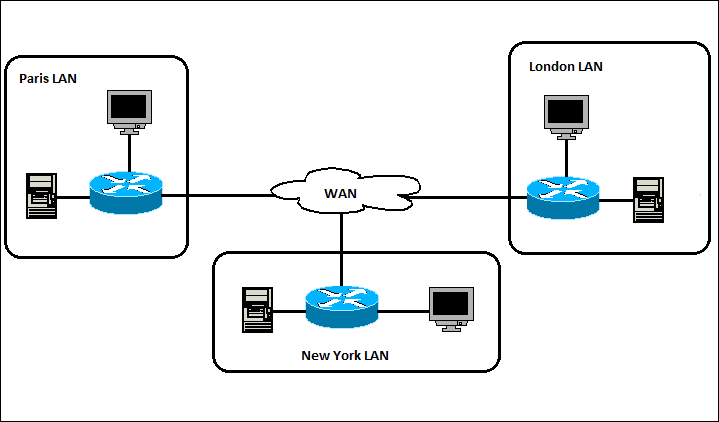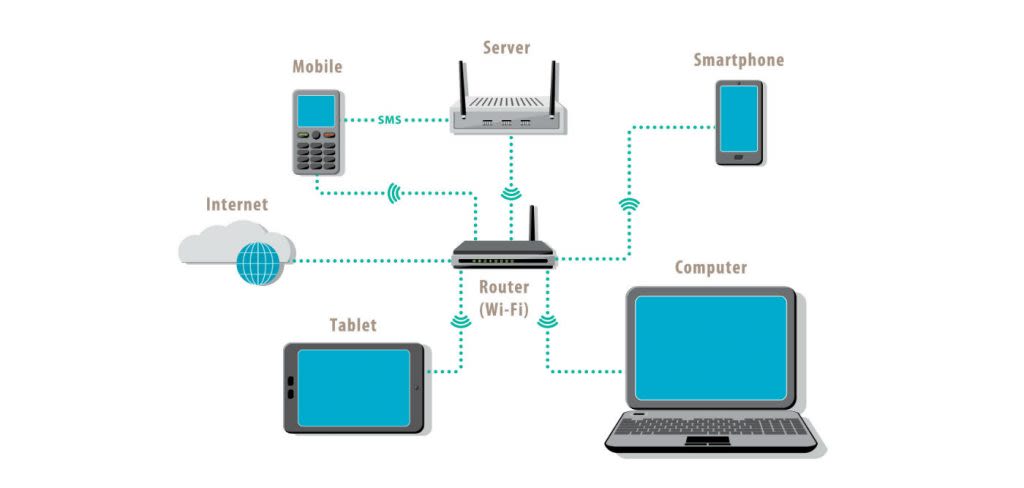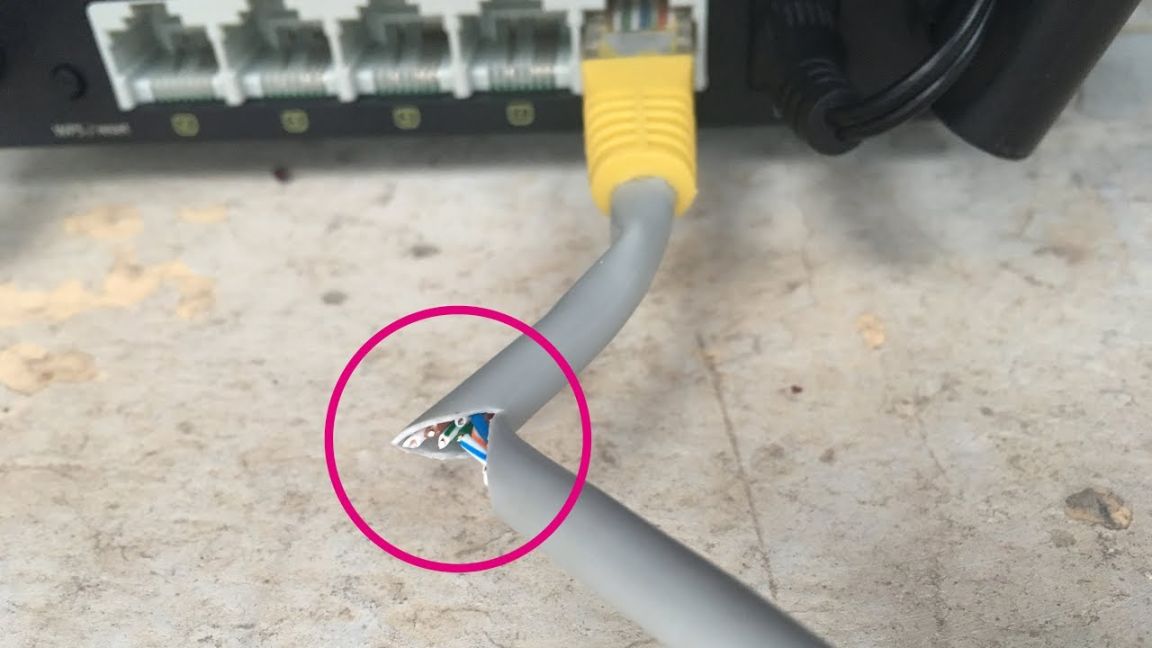WAN versus LAN: What’s LAN got to do with it?
Wide area networks (WAN) and local area networks (LAN) are both critical aspects of your network connectivity. Learn the differences and importance of each.

Nov 16, 2021
SHARE
Tech terms can be an alphabet soup of acronyms and one letter can make a huge difference. Case in point: WAN vs. LAN. While they sound similar, these acronyms refer to two separate types of critical networks that differ vastly from each other.
We covered the various types of WAN networks in depth in a previous post. Here we will review the types of WANs and ask the critical question: what’s LAN got to do with it?
Wide Area Network (WAN)

Photo Source: StudyCCNA
As its name indicates, a WAN provides connectivity over a large geographic area, enabling businesses with multiple locations to connect with each other and their cloud / data centers. A WAN is essentially a network of networks.
While the very first WANs referred to telephone networks, modern WANs refer to public and private computer networks. The Internet, for example, is a public WAN (and the largest, FYI). Conversely, a corporate Intranet is a private WAN.
The purpose of a WAN is to combine and connect sub-level LANs. Which begs the question, who needs a WAN when a LAN can be broken?
Local Area Network (LAN)

Photo Source: OmniSci
LANs, used by college campuses, offices, and residences, connect devices over a much smaller geographic area compared to a WAN. A network including as small as two devices is considered a LAN, while a LAN can include thousands of devices. These devices can be computers, smart phones, scanners, servers, and even printers.
When you have the option of which printer to send your document to at the office, and you know that printer #3 never has indigo ink and printer #4 is always the fastest? You can thank your LAN for that optionality.
Old school LANs were implemented with Token Rings, DECnet, FDDI, and ARCNET. The best developments of the 1980s were the use of Ethernet over cable for Wired LANs and Tina Turner’s biggest hits. Wireless LANs are also an option, such as a home's WiFi network, more affectionately known as a WLAN (more acronyms, please!).
Just like hearts, LANs can be broken.

Photo Source: NETVN
WAN Types
WANs either have dedicated or switched connectivity. The three most popular WAN technologies prevalent today are point-to-point (P2P) connectivity, multiprotocol label switching (MPLS), virtual private network (VPN), and software-defined wide area networks (SD-WANs). We previously discussed the pros and cons between VPN and SD-WAN here.
If you're looking for a deeper dive on the information below, check out our WAN Connectivity Pricing Guide!
P2P
Offering faster data speeds than switched WANs, a P2P WAN solution connects several satellite or sub-level LANs with dedicated bandwidth for just one organization or company. With the ascent of optical carriers, some enterprises look to leverage wavelength division multiplexing (WDM) technology with P2P to achieve faster data speeds and facilitate data replication and access.
For a deeper dive on the types of P2P links, check out Point to Point Connections vs. Wave Circuits.
MPLS
A highly reliable and scalable technology, multiprotocol label switching (MPLS) offers a high quality of service (QoS) with relatively low latency. With MPLS, carriers can easily prioritize different types of traffic depending upon need. For example, a company may prioritize video conferencing or VoIP over less time-sensitive data such as emails.
Private carriers always back MPLS service with service level agreements (SLAs). Yet MPLS is a pricey option for many small and mid-size businesses (SMBs). Setup is time-consuming, service commitments are rigid, and engineering redundancies into private networks is costly. This can lead to flexibility issues, especially when dealing with multiple carriers in different regions and various contractual agreements.
To enhance MPLS flexibility, network engineers use segment routing (SR) to simplify traffic management across network domains.
SD-WAN
A more flexible and cost-effective option to MPLS is software-defined WAN (SD-WAN). Conceptually similar to the virtualization techniques used in data centers and web hosting, an SD-WAN solution uses a combination of consumer-grade Internet connections and dedicated circuits that create a highly available underlay network.
As Network World Senior Editor Michael Cooney states, "SD-WAN's driving principle is to simplify the way big companies turn up new links to branch offices, better manage the way those links are utilized–for data, voice or video– and potentially save money in the process."
Now the important part - what does LAN have to do with it?
LAN Types
The fact of the matter is, WANs would not exist without LANs. Without the ability to connect your local devices, there would be no need or ability to connect on a broader scale. In fact, before WANs revolutionized the reality of a computer network, enterprises would often operate over “minicomputers” that were distributed and utilized by departments, with no interconnectivity between departments. We found a great resource on the evolution of computer networks here.
Today, there are two basic types of LANs and both can be either cabled or wireless.
Client/Server LAN
Composed of several "clients" (endpoint devices) connected to a hub server. The server manages device access, file storage, application access, and network traffic. This is the type of LAN deployed by SMBs and enterprises.
Peer-to-Peer LAN
Each endpoint is equal to the other devices found within the LAN and share equally in network functions. Hence, it has no hub server and cannot shoulder the massive workloads typically seen in client/server LANs. A small business/home network environment is most appropriate for a peer-to-peer LAN.
Why WANs and LANs Matter
Businesses should understand the importance of computer networking beyond the jumble of acronyms. Network management facilitates optimal communication to maximize productivity, profits, and the use of company resources.
A thorough understanding of these networks will drive decisions when configuring WANs and LANs for your company and employees.
The next time you ask yourself, “What’s LAN but a secondhand data locomotion?” remember that, while countless buzz word acronyms lie in the world of WAN, you should never forget the importance of a high quality LAN.
Want to learn more about how Lightyear can help you?
Let us show you the product and discuss specifics on how it might be helpful.
Not ready to buy?
Stay up to date on our product, straight to your inbox every month.
